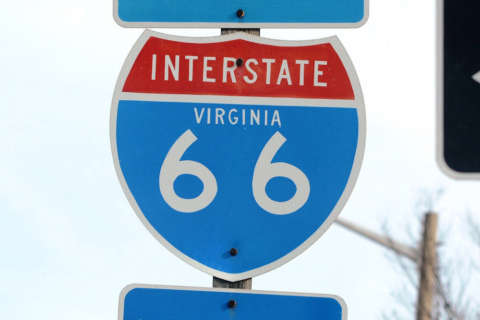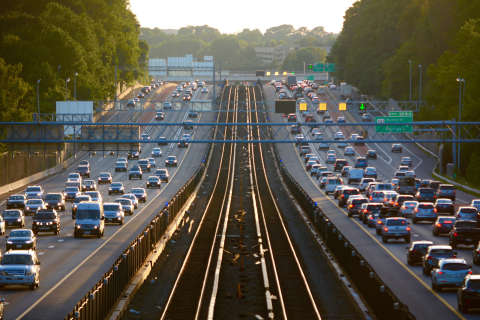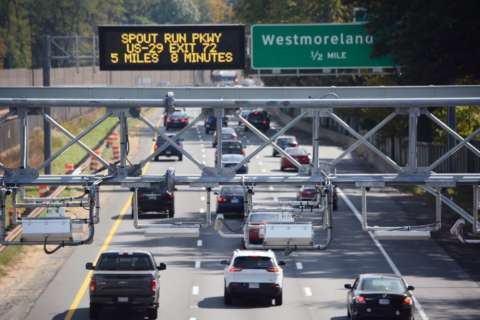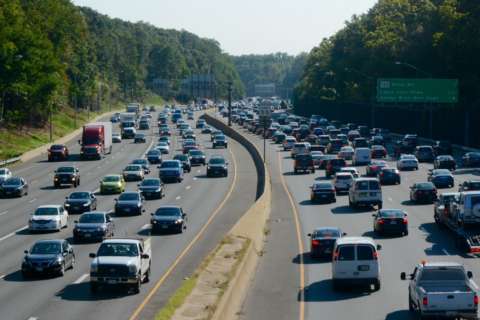WASHINGTON — Tolls for solo-drivers and expanded rush-hour periods begin Monday, Dec. 4 on Interstate 66 inside the Capital Beltway.
Beyond the basic new rules of the road, WTOP listeners submitted a series of questions about the cost of tolls and how drivers will pay, which we took to state transportation officials.
Who has to pay, and how much? How do the tolls work?
Any driver riding alone during the restricted times, including traffic to or from Dulles International Airport and hybrid vehicles, must pay an automated toll that rises and falls based on traffic in the lanes.
“It’s dynamically priced … basically that’s an algorithm that measures congestion, and as the congestion increases the toll increases, and as the congestion goes down, the toll decreases,” VDOT Tolling Division Administrator David Caudill said.
The idea is similar to the tolls for the 95 and 495 Express Lanes, but Caudill declined to predict what solo drivers will be asked to pay.
“It really depends on the response to the facility and how popular it is. We’ll know more once it stabilizes and the user group is established and they kind of tell us what that level of pricing is to determine what it takes to maintain reasonable speeds,” he said.
The goal is to keep traffic between the Beltway and U.S. 29 in Rosslyn moving at least 45 mph.
Caudill said previous estimates of $17 average round-trip tolls are a few years old.
“That was way back when we did traffic and revenue studies, and those are just basically ballpark kind of things; we really don’t know. And we really don’t want to say because we know we’d be wrong,” he said. “We’re waiting for this facility to open; we’re going to let the dynamic pricing do what it’s designed to do, measure that congestion, raise pricing accordingly. The idea being we don’t want to impede progress of our HOV users.”
Tolls are expected to vary by time of day and day of the week, Deputy Transportation Secretary Nick Donohue said.
“Friday is probably not always going to be the same as Monday. Wednesday’s probably not going to be the same as Tuesday. It’s all depending on how people want to use it,” Donohue said. “If you go at the height of rush hour, the toll’s going to be higher than if you go earlier or later … when there’s more folks who want to use it, the toll’s going to go up and when less folks want to use it, the toll’s going to go down.”
Will I know the price before I get on the road?
“All the entrances have a minimum of two signs, and those signs provide pricing at that moment. The first one is an advisory sign; the next sign is a confirmation sign. That price you see on the confirmation sign will be the price you would pay,” Caudill said.
The signs each show the shortest trip, the longest trip and one middle-length trip.
“Not all trips are shown just because of signing limitations, but anything in between those trips can be interpolated so you have a good idea what your trip price would be,” Caudill said.
VDOT has promised an app that will show current prices and allow drivers to look at prices at past dates and times.
“There’s going to be a feature later on that shows you, on a given toll period, how the pricing looked, and that will enable people to say, ‘Well I know if I leave 15 minutes early it’s on the lower side of the curve, if I wait until 8:15 that seems to be the peak point for pricing.’ So, that information will be forthcoming,” Caudill said. “We’re thinking six weeks we’ll be able to generate some historical pricing just to give people an idea what to avoid if they want to pay less, as far as the single-occupancy tolling.”
The price will not change for drivers already on the road once they enter, even as it continues to change for new drivers entering the highway.
“There’ll be plenty of signs. No one’s ever going to be surprised when they get on the road and not know what that toll is going to be,” Donohue said.
What do I get for paying a toll? Where does the money go?
Drivers who pay the toll get a promise of free-flowing traffic.
The money from the tolls, estimated to be $18 million in the first year, will support tolling operations and maintenance and go toward transportation improvements along the I-66 corridor.
“We’ve already introduced new bus service … from Prince William, Loudoun, Fairfax and other places throughout this corridor,” Donohue said.
Fairfax County, for example, starts the new Fairfax Connector Route 699 Dec. 4 from the Fairfax County Government Center Park & Ride area directly to Foggy Bottom.
The Northern Virginia Transportation Commission will continue to direct those excess funds for the next 40 years.








